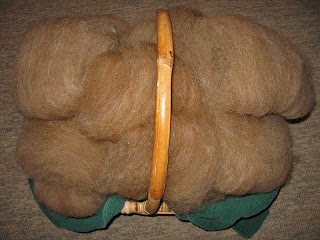It's officially spring at Yarnspinnerstales and that means spring cleaning. Windows? Nope, not a chance. But give me a fleece straight off the sheep and I jump at the chance to be up to my elbows in soapy water.
Here's what we are washing today:
 This is the Shetland fleece I had spread out on my car hood several podcasts ago, and now I am podcasting about just how to take it from this state into fluffy lovely carded batts ready to spin.
This is the Shetland fleece I had spread out on my car hood several podcasts ago, and now I am podcasting about just how to take it from this state into fluffy lovely carded batts ready to spin.If there's any doubt, wool really does take to hot soapy water. It just takes a very gentle touch, while it is wet.
 I talk in my podcast about not really handling the fleece much, just moving it around as you work. This next photo shows how I just push the fleece to the back of the sink, in order to let the water drain out. The photo is actually of one of the rinses, which is why the soap suds are now gone.
I talk in my podcast about not really handling the fleece much, just moving it around as you work. This next photo shows how I just push the fleece to the back of the sink, in order to let the water drain out. The photo is actually of one of the rinses, which is why the soap suds are now gone.
After the fleece is rinsed free of any soap residue, you want to try and get as much water out of it as possible. Although you can just let it drain, or keep dabbing it with dry towels, I prefer the mesh bag method. You need a large mesh bag with a closeable top. Here's a picture so you know what I mean.
 The fleece goes in the bag, and then in the spin cycle of the washer for 10 seconds. This creates a very fluffy and almost dry fiber. This fiber needs to be spread out so it can dry. I use what I call a sweater dryer, available in many of the mail order catalogs. This one hangs from my shower rod and actually has a furnace vent blowing straight on it, so the fleece dries quickly when I put it up this way.
The fleece goes in the bag, and then in the spin cycle of the washer for 10 seconds. This creates a very fluffy and almost dry fiber. This fiber needs to be spread out so it can dry. I use what I call a sweater dryer, available in many of the mail order catalogs. This one hangs from my shower rod and actually has a furnace vent blowing straight on it, so the fleece dries quickly when I put it up this way.

Fluffy fibery goodness, all dry and ready to card or comb.

I wasn't sure how this fleece would do on my drum carder, because the staple length of the fleece is very long. However, it carded wonderfully. I still had to pull some vegetable matter from the fiber before carding, and much of the smaller bits fell out as I carded. I decided to pull half of the drum off at a time, which still made nice big batts each weighing around 3/8 oz.

Not bad for what I considered the 'worse' part of the fleece! It can only get better from now on. I always do the worse bit first, sort of a fleece washing swatch. That way I can check out each step of the planned process and if any of the steps are not satisfactory, I can change my plans before getting to the best part of the fleece. As it turned out, I will be able to process the rest of this fleece in exactly the same manner as I did with this bit. There is still some hay bits in these batts, easily removed as I spin. I forgot to weigh the swatch bit before I put it in the water, but the final batts produced 7.5 oz of spinnable fiber. I suspect knowing that lanolin adds weight and that I did toss about a third of it as I worked through the process (too much hay in it, or coarse fibers) I probably did have over 16 oz (1 lb) in the original bunch of fleece.
Be sure to check out the podcast!
CW